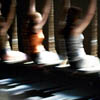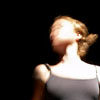


|
In
1997 I received one of the inaugural Australia Council Emerging Artist
Fellowships to make a new art work. I was living in a First World country,
was over-fed, white and privileged. I of course, made a work about grief,
having never experienced it, and was well contented in my own self-importance
for a good many months. I thought my ‘career’ as an artist
was on track. It wasn’t until the end of that year when all the
Emerging Artists (six of us) were asked to write about where we might
be in 10 years that I noticed all of their responses were identical and
without either passion or anger. I thought that was remarkable coming
from a group purported to be the most innovative group of young performance
makers in the country. Aren’t the young the possessors of anger,
discontent and cultural change? Not the youth I was hanging out with.
In 10 years I assumed my current struggle would be too much and I would
probably be a bitter, unemployed alcoholic. Looking at what was successful,
it occurred to me for the first time that I was living in a place where
art was a ‘career’, that what we did was marketable and that
no one wanted to hear about alternative pathways because it was too hard.
We were living in a different age to what I thought we were. Perhaps I am romanticising
the vast revolutions of the 60s, but I fear the English speaking world is being
colonised by a very strong conservative trend. I look at contemporary performance
and all I see is artwork that can be sold or marketed. In an attempt to shut
us up, the fashion of the day is all about packaging, certainly not about content.
Is it economic rationalism? Is it this conservative government? Or is it just
that young people are too damn content to care any more?
I have been wondering why there is a complete dearth of interesting performance
for quite some time now. But to temper my cynicism I decided to talk with Mark
Gordon, Director of the Choreographic Centre in Canberra to see what observations
he had of contemporary performance. Mark works with choreographers from all around
Australia and is passionate about new performance. He has been the Director since
its inception in 1996 and has seen a change in the kind of works being made in
Australia - the mid 90s were a time of upheaval in the arts and there is only
now a settling of those events, which impacts on the kind of work being created
now. Social trends change. Do artists instigate or follow that change? And if
it isn’t the artists or the scientists, they who does? The politicians
who are elected by us, the people?
Mark took the Directorship of the Choreographic Centre in a time when dance was
in crisis. It was a period where audiences were clearly deserting performance:
the collapse of the share market in 1987 was having a trickle down effect on
what people consumed, the word ‘recession’ was being openly discussed
and there was a definite performance fatigue of audiences, even the converts,
toward minimal and self-referencial dance of the 80s and early 90s. The major
companies were no longer funded by Peer Assessment of the Australia Council and
the Dance Fund was no longer able to fund the number of small dance companies
that had emerged. Dance companies began to close, dancers’ contracts were
no longer 12 months and the established tradition of being a dancer in a company
and then graduating to be a choreographer was being challenged. The crisis was
real and it produced the need not only for a Choreographic Centre, but also for
choreographers who could and wanted to work out side the establishment. Dancers
began to move between companies to gain work all year and that changed the kind
of work small companies and independent choreographers made and the kinds of
choices performers felt they had as artists. This was an exciting time for young
artists. I was an emerging artist at the time and felt like I could take on the
world.
Five years later and with all these alternative pathways for young dance makers,
is there new art and original ways of creating and thinking amongst dance makers?
To my surprise Mark who is an eternal optimist, is also seeing a resurgence of
conservatism. I was shocked. And it posed the question: do we need crisis to
make good art?
Mark’s experiences come from working in a centre solely dedicated to nurturing
performance practitioners. He has observed that the majority of the artists he
sees are not working or desiring to work radically out of the tradition: most
choreographers are still trying to make their mark with a ‘full length
work’, with an ensemble of dancers, in a black box with a stationary audience.
It is not an observation that holds any value judgements but rather a comment
on the social conditioning of current young contemporary dance makers. He confirmed
my suspicion that choreographers are not really challenging the establishment,
that there is a fear of the radical, the unorthodox and of risk, because if it
doesn’t work then you wont get funded again. Or, it wont be seen by the
right people who might ask you to make a work for their company. Or, even more
surprising, that the majority of young choreographers are intentionally working
in ways that make them ‘acceptable’ to artistic directors of companies
established over 20 years ago. I asked him if there were any artists who had
come through the Centre who had challenged those ideas. He thankfully named a
few art makers who were totally disinterested in the mainstream and were passionate
about creating something different. They were mostly working with technology
or artists that were confident not to show anything at the end of the Fellowship.
So where is it coming from – this fear?
If the focus in training is on value judgements, technique, performance, beauty
and passivity then it would appear we are beating bravery out of our young people.
And is it just in dance? Social risk-taking also impacts on the artistic process.
Australian’s of my generation where bombarded with ideas of risk being
dangerous in the safe sex campaigns of the 80s. We were too young to have started
taking risks and have matured in a time of conservative governments, spending
and a push toward tradition. After two decades of revolution it seems that society
wanted a rest, and those of us caught up in the hiatus have let it shape our
identities. The problem is that quite a lot of us reinterpreted it as apathy.
And if you don’t believe me go to some contemporary art and you will see
what I mean. The worst thing about risk these days is that the façade
of danger is a construct: sex and pregnancy are happening earlier, explicit language
is the norm, drug taking is paraded by the fashion industry as an accessory,
and yet none of these things are truly about taking risks. There is no revolution
here. There is no pro-action in these constructs. Young people don’t care.
And the media megalomaniacs are making sure we never will. The emergence of ‘real
tv’ where people sit in their living rooms and watch other people in their
living rooms via a television is one of the saddest cases in point. And they
are the highest rating television shows, as gameboys, designed to capture you
for longer in front of the tv, are the highest selling toys. Cutting education
back to a ridiculous level, allowing vast media empires in the hands of a few,
voting in men who admit to extreme conservatism – this all has an impact
on how we as artists see our job.
And our job is no longer to change the world, our job is to get a really nice
little work that doesn’t cost too much, can be toured, is full length and
doesn’t challenge the audience too much. We are competing with life style
magazines.
I asked Mark how he felt about the future. And yet again he surprised me. He
feels that the last 20 years of dance making in Australia has gone from radical
to extreme conservatism and that right now, today even, he thinks that the pendulum
is swinging back. As he left he said something that involved more potential risk
than I have heard in years: He feels that we are going to see a move, not only
in the arts, but in general society, towards social realism. This is where passion
lies – in making people rather than structures the focus of policy and
art. The current policy in the ACT called ‘Social Capital’ demands
all aspects of government value who and what we are here and now. This means
that all decisions, whether road building or health, must deliver ‘arts
capital’ key issues within their decisions rather than after the event.
This idea sees the arts as intrinsic to society and reinforces to artists that
society is intrinsic to art making. Is a whole new ball game. To make relevant
art, and to make art relevant, artists need to remember that they are part of
a society. And if you don’t like where you are at, then it is your job
as an artist to change it. Not just to watch tv about it. Mark’s final
word on his hopes for the future were that he would like to see a time when choreographers
take risks to make all kinds of art, to tell stories in a variety of ways. The
key, he thinks, to sustainable and relevant art is diversity.
I’m holding my breath. Are we really at a turning point? in this time of
homogenised culture, histories and thinking - that is a joyful prediction.
July 2001
|
|

